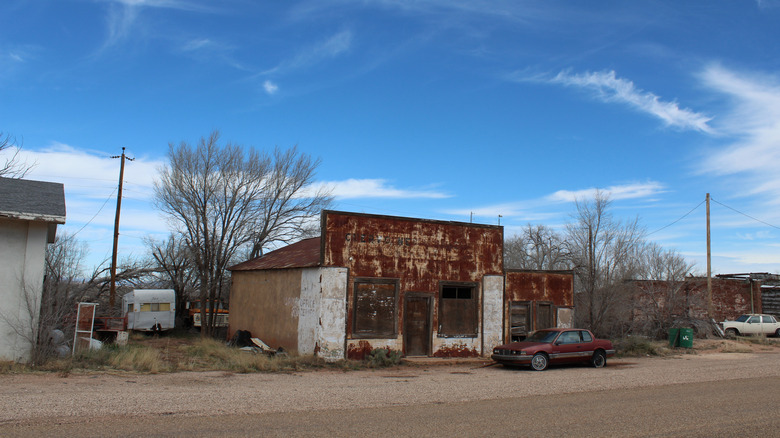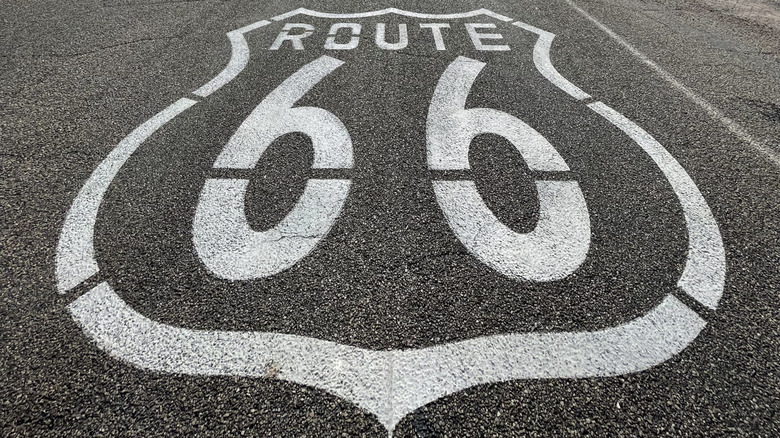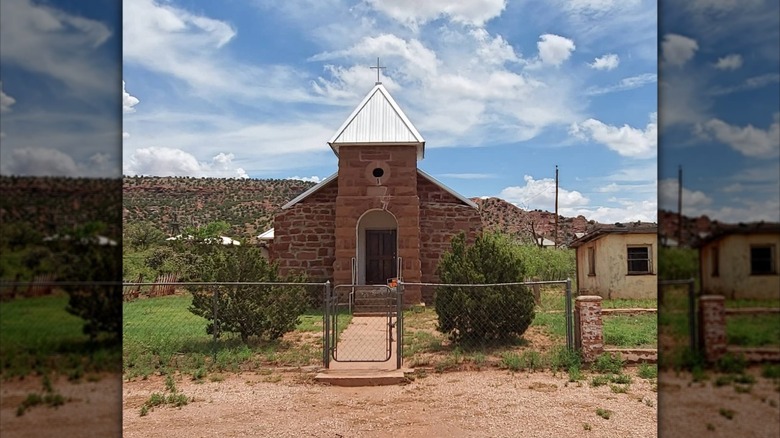New Mexico's Abandoned Ghost Town Along Route 66 Was A Once-Thriving Community
Most ghost towns exist at the far end of a dusty, lonely road where a tumbleweed is more likely to pass through than an automobile. This is what makes Cuervo, New Mexico, different. Unlike other abandoned settlements whose remote locations often doomed them from the start, this ghost town sees thousands of cars pass by most days on Route 66 or Interstate 40. Cuervo sits between Albuquerque and Santa Rosa to the west and Tucumcari, considered one of the state's best Route 66 attractions, to the east. While cars may pass through, the activity rarely makes its way into the long-abandoned town, which is notably listed in the 1981 book "New Mexico's Best Ghost Towns."
Like so many deserted towns in the U.S., Cuervo's origin story starts with a train stop. At the dawn of the 20th century, Chicago, Rock Island & Gulf (CRI&G) extended its rail route from the Texas Panhandle into Eastern New Mexico, laying down new siding tracks through Cuervo and making it a water stop. It appears there was a small settlement there at the time, but it officially became a town in 1901. A post office opened the following year, and ranchers started to arrive over the next decade as the rail lines helped with cattle movement. The town grew into a small but thriving community. It had its first setback when CRI&G shifted its train traffic to Tucumcari and Santa Rosa; however, the emergence of the automobile and Route 66 kept the town going.
Cuervo thrived with the arrival of Route 66
After rail traffic waned, car traffic grew with the arrival of Route 66 in the 1920s. The historic highway cut right through the middle of town, providing business to local gas stations, hotels, and stores. Dubbed the Mother Road by John Steinbeck in "The Grapes of Wrath," Route 66 stretched nearly 2,500 miles from Chicago to Los Angeles as one of the first continuous stretches of paved highways in the country. The highway connected smaller towns like Cuervo to larger cities and markets. As a result, Cuervo grew into a thriving community with a population of around 300 residents in the early 1940s. By the end of the decade, however, that number was reduced by half.
The arrival of the four-lane I-40 in the late '60s provided another chance at a comeback, but it may have done more harm than good. It cut right through the middle of town, splitting it in two with four streets to the south and two to the north, ultimately dividing its last few residents. In the decades that followed, the schools closed, and most people left the area. Some citizens remain today, as does its 88417 zip code, and the 1915 red sandstone Santo Niño de Atocha Catholic Church still holds occasional services. Besides that, general town services have mostly ceased, and Cuervo was officially abandoned in 2011. The most emblematic symbol of its past, ironically, is the return of train activity through the ghost town several times per day.
Reaching and exploring what remains of Cuervo
The name Cuervo means "raven" or "crow" in Spanish, a common bird in the area, but many believe it's named after one of the nearby peaks, Cuervo Hill or Cuervito Peak. Much of the desert town is relatively intact, and several adobe houses are still standing, another example of what makes it different from most other ghost towns. It also has a few residents who remained despite its general abandonment. Considering the isolation of the town, one might assume these holdouts are not big fans of socializing and tourists wandering onto their property, so visitors should be mindful and cautious when exploring the town.
For those who want to visit, Cuervo is about 17 miles northeast of Santa Rosa and 135 miles east of Albuquerque, home to Albuquerque International Sunport (ABQ). If heading down Route 66, take Exit 291 and head to the frontage road. It's a quick and accessible stop that gives you the opportunity to take haunting pictures of the popular ghost town. Interestingly, after offering no general services for decades, Cuervo now has a gas station on the north side of the freeway, though reports suggest the prices might be a bit higher than in nearby Santa Rosa.
For those interested in seeing more abandoned settlements, the Turquoise Trail between Albuquerque and Santa Fe connects a chain of near-ghost towns like Cerrillos, as well as Madrid, a stop that boasts charm, art, and cuisine. For more traditional exploration, consider Raton, with its historic railroad, downtown, and beautiful mountain scenery.


